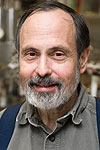English professor Buddy Levy back on History Channel
adriana
Narrative historian and WSU English professor Buddy Levy is making a return to the History Channel.
Levy, the author of a 2005 biography about early American adventurer Davy Crockett, is among the experts interviewed for the cable network’s latest documentary series “The Men Who Built America: Frontiersmen.” He appears in episodes 3 and 4, which air March 21 and 28.
“When we first talked it was clear they were looking to understand more than just who the people were,” Levy said. “They wanted to know about the frontier and what it was like to set out into the unknown.”
The new series by executive producer Leonardo DiCaprio explores the formative period of history featuring what it describes as the first 75 volatile years of the United States—from the Revolution through the California Gold Rush. It was a time when historical figures such as Crockett, Daniel Boone, Meriwether Lewis and William Clark, John Fremont and Andrew Jackson spearheaded the fledgling nation’s expansion west into uncharted land.



